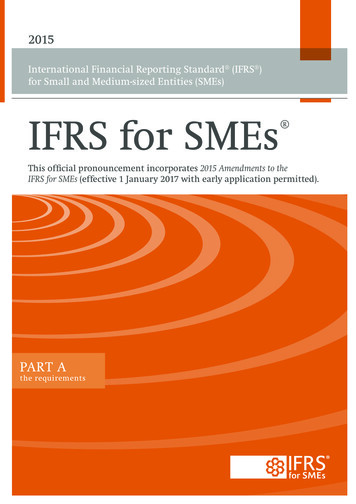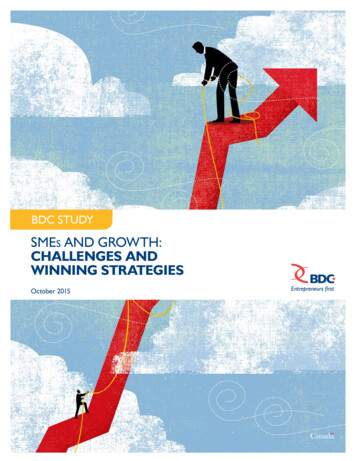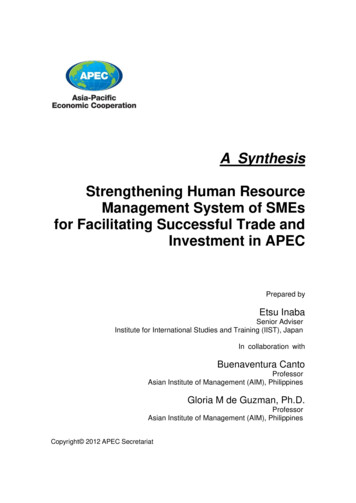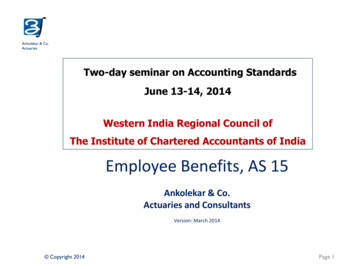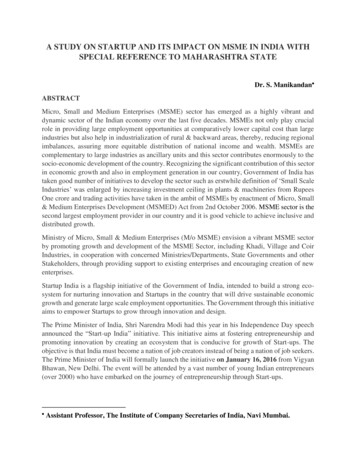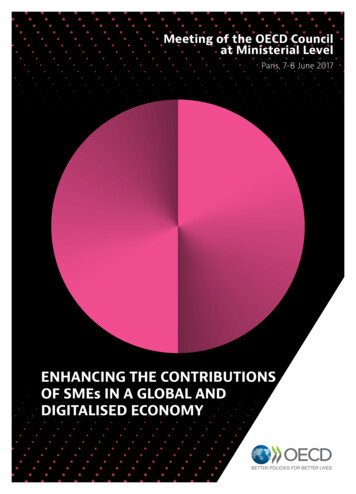
Transcription
Meeting of the OECD Councilat Ministerial LevelParis, 7-8 June 2017ENHANCING THE CONTRIBUTIONSOF SMEs IN A GLOBAL ANDDIGITALISED ECONOMY
Enhancing the Contributions of SMEsin a Global and Digitalised Economy
TABLE OF CONTENTS1. SMEs are essential for delivering more inclusive globalisation and growth .52. SMEs make diverse contributions to economic and social well-being, which could be furtherenhanced .6SMEs play a key role in national economies around the world, generating employment and valueadded and contributing to innovation. SMEs are central to the efforts to achieve environmentalsustainability and more inclusive growth. However, these contributions vary widely across firms andacross countries and sectors. Better access to global markets and knowledge networks can strengthenSMEs’ contributions, but trade and investment barriers undermine SME participation, and poorphysical and ICT infrastructure prevents SMEs from operating efficiently and accessing internationalmarkets at competitive costs. Digitalisation offers new opportunities for SMEs to participate in theglobal economy, but SMEs are lagging behind in the digital transition and disruptive effects need to beconsidered.3. The business environment is critical to enhance SME participation in and benefits from an open andintegrated economy .14Certain features of the institutional and regulatory framework result in disproportionate burdens onSMEs. Inefficient insolvency regimes limit business dynamism, restructuring of viable firms andaccess to external finance by SMEs. High costs of tax compliance fall disproportionately on small andyoung firms. Public sector integrity and transparency, public administration efficiency, and the qualityof public services are essential for a level playing field.4. The ability to access strategic resources is critical for SME competitiveness .15For many start-ups and SMEs, access to finance in the appropriate forms is hampered by a range ofdemand- and supply-side obstacles. Skills shortages, poor management practices and workforcetraining limit SME productivity and innovation. Access to public procurement is generally moredifficult for SMEs than for large firms.5. A cross-cutting perspective on SMEs is needed .17An OECD Strategy for SMEs can support policy making in OECD and non-OECD countries.REFERENCES .192
FiguresFigure 1. SMEs are the main source of jobs in the business sector .6Figure 2. SMEs are less connected than large firms to international knowledge networks .7Figure 3. There are large differences in the SME contribution to employment and value added acrosscountries, particularly in manufacturing .10Figure 4. SMEs account for a larger share of value added in international trade when indirect linkagesare taken into account .11Figure 5. SMEs lag behind in the adoption of more sophisticated digital technologies .13Figure 6. The gap in credit costs between SMEs and large enterprises has widened .163
COUNTRY CODESThe figures in this document use ISO codes (ISO3) for country names as listed lgariaCanadaSwitzerlandChileColombiaCroatiaCzech reaLatviaLithuaniaLuxembourgMexicoNetherlandsNew ZealandNorwayPolandPortugalRussian FederationSlovak RepublicSloveniaSpainSwedenSwitzerlandTurkeyUnited KingdomUnited StatesDEFINING SMEs FOR STATISTICAL PURPOSESIt should be noted that a standard international definition of small and medium-sized enterprise (SME)does not exist. SMEs are defined differently in the legislation across countries, in particular because thedimension “small” and “medium” of a firm are relative to the size of the domestic economy. For statisticalpurposes, the OECD refers to SMEs as the firms employing up to 249 persons, with the followingbreakdown: micro (1 to 9), small (10 to 49) and medium (50-249). This provides for the best comparabilitygiven the varying data collection practices across countries, noting that some countries use differentconventions.NOTE: The statistical data for Israel are supplied by and under the responsibility of the relevant Israeliauthorities. The use of such data by the OECD is without prejudice to the status of the Golan Heights, EastJerusalem and Israeli settlements in the West Bank under the terms of international law.4
1.This document provides a synthesis of the current state of knowledge about small and mediumsized enterprises (SMEs) and their contributions to economic and social well-being. It describes the diversecharacteristics of SMEs and the opportunities and challenges they face in a globalised and digital economy.It also identifies areas where knowledge or data gaps exist and where more analysis is needed. Thedocument presents the case for launching the future development of an OECD Strategy for SMEs, to helpMembers and Partners take a coherent approach to policies which impact and/or target SMEs, includingacross levels of government; enhance policy synergies; and address potential trade-offs. The futuredevelopment and implementation of an OECD Strategy would help governments level the playing field forSMEs and enable them to enhance their contributions to inclusive growth in different economic and socialcontexts.1.SMEs are essential for delivering more inclusive globalisation and growth2.In many countries, and in particular OECD countries, governments are facing the challenges oflow growth, weak trade and investment, and rising, or persistently high inequality (OECD, 2016a). Theyalso face a growing dissatisfaction among citizens with the current state of affairs, which is alsomanifesting itself in the form of a backlash against globalisation and technological change. Against thisbackdrop, there is a need to create the conditions that enable the benefits of open markets andtechnological progress to be enhanced and shared more broadly across the economy and society.3.SMEs are key players in the economy and the wider eco-system of firms. Enabling them to adaptand thrive in a more open environment and participate more actively in the digital transformation isessential for boosting economic growth and delivering a more inclusive globalisation. Across countries atall levels of development, SMEs have an important role to play in achieving the Sustainable DevelopmentGoals (SDGs), by promoting inclusive and sustainable economic growth, providing employment anddecent work for all, promoting sustainable industrialisation and fostering innovation, and reducing incomeinequalities.4.However, boosting SME potential for participating in and reaping the benefits of a globalised anddigital economy depends to a great degree on conducive framework conditions and healthy competition.Due to constraints internal to the firm, SMEs are disproportionately affected by market failures andbarriers and inefficiencies in the business environment and policy sphere. SMEs’ contributions also dependon their access to strategic resources, such as skills, knowledge networks, and finance, and on publicinvestments in areas such as education and training, innovation and infrastructure. Furthermore, for a largenumber of SMEs, a conducive environment for the transfer of business ownership or managementrepresents an important condition for ensuring business viability over time, with implications for jobs,investment and growth.5.These issues have gained prominence in the policy debate, as SMEs in some countries continueto struggle with the prolonged impact of the 2007-08 global crisis, which hit new and small businessesdisproportionately and marked a widening of the gap in productivity growth between SMEs and large firms(OECD, 2017a, 2017b). This gap is an important driver of the observed rise in inequality, including wageinequality, in many countries (OECD, 2016a).6.The SME policy space is complex. It comprises framework conditions; broad policies that impactSMEs; and specific targeted policies. These areas often cut across the boundaries of ministries andgovernment agencies, as well as across levels of government. Since SMEs are often embedded in localeco-systems, which represent their primary source of knowledge, skills, finance, business opportunities andnetworks, it is also important to consider factors affecting framework conditions at the local level, and howpolicies developed at national level are tailored to local conditions, as well as how they coordinate withpolicies that are shaped at the regional or territorial level (OECD, 2016e). Furthermore, policy strategies5
should take into account the changes in regulations, markets and technologies that occur across borderswhich may affect SMEs’ opportunities and performance.7.The sections below examine the opportunities and challenges SMEs face in a global and digitaleconomy, building on the OECD’s large body of analysis conducted across OECD Committees on SMEs,including on finance, innovation, taxation, regulation, digitalisation, employment, skills, trade,internationalisation and global value chains (GVCs), environment, among others, as well as on its uniquestatistical expertise. Taken together, these findings present a strong case for developing a cross-cuttingOECD Strategy for SMEs, which can advance the debate and catalyse improvements in frameworkconditions and SME policies in Members and non-Members to deliver more sustainable and inclusivegrowth.2.SMEs make diverse contributions to economic and social well-being, which could be furtherenhancedSMEs play a key role in national economies around the world, generating employment and valueadded 8.In the OECD area, SMEs are the predominant form of enterprise, accounting for approximately99% of all firms. They provide the main source of employment, accounting for about 70% of jobs onaverage, and are major contributors to value creation, generating between 50% and 60% of value added onaverage (Figure 1) (OECD, 2016b). In emerging economies, SMEs contribute up to 45% of totalemployment and 33% of GDP. When taking the contribution of informal businesses into account, SMEscontribute to more than half of employment and GDP in most countries irrespective of income levels (IFC,2010). In addition, SME development can contribute to economic diversification and resilience. This isespecially relevant for resource-rich countries that are particularly vulnerable to commodity pricefluctuations.Figure 1. SMEs are the main source of jobs in the business sectorPercentage of all persons employed, total business economy, 2014 or latest available yearNotes: For Canada, Switzerland, Israel, Japan, Korea, the United States and the Russian Federation, data do not include nonemployers. Data for Korea and Mexico are based on establishments. Data for the United Kingdom exclude an estimate of 2.6 millionsmall unregistered businesses. For Australia, Canada and Turkey the size class 1-9 refers to 1-19.Source: OECD (2017), Entrepreneurship at a Glance 2017, OECD Publishing, Paris, forthcoming.6
and contributing to innovation9.The contribution of SMEs to innovation dynamics has increased in recent decades, as incomegrowth, more niched market demand and changing technologies have enabled SMEs to strengthen theircomparative advantages and reduced the structural disadvantages stemming from resource constraints andlimited ability to reap economies of scale.10.While not all SMEs are innovative, new and small firms are often the driving force behind thesort of radical innovations that are important for economic growth, since they can work outside ofdominant paradigms, exploit technological or commercial opportunities that have been neglected by moreestablished companies or enable the commercialisation of knowledge that would otherwise remain uncommercialised in universities and research organisations (Baumol, 2002; OECD, 2010a). For instance,SMEs account for about 20% of patents, one measure of innovation, in biotechnology-related fields inEurope (Eurostat, 2014). SMEs also contribute to value creation by adopting innovation generatedelsewhere, and adapting it to different contexts through incremental changes, and by supplying new orniche products which respond to diverse customer needs. They also contribute by serving locations that donot have a large enough scale to attract larger firms.11.The knowledge-based economy, a rise in non-technological innovation and the emergence ofopen or network-based modes of innovation have also enabled new and small firms to increase theircontributions to innovation (OECD, 2010a). Innovation by SMEs is largely influenced by knowledgespillovers, access to networks and opportunities to partner with other players, including larger enterprises.Globalisation has increased the importance of cross-border collaboration in innovation – both in obtaininginputs for innovation (ideas, finance, skills, technologies) from abroad and in exploiting its outputs(products and services, patents, licenses, etc.) in foreign markets. However, a key challenge for manySMEs is to identify and connect to appropriate knowledge partners and networks at the local, national andglobal levels, as well as to develop appropriate skills and management practices for co-ordinating andintegrating knowledge created by external partners with in-house practices and innovation processes(Figure 2) (OECD, 2013b).Figure 2. SMEs are less connected than large firms to international knowledge networksFirms engaged in international collaboration for innovation, by firm size, as a percentage of product and/or processinnovating firms in each size category, 2010-12Source: OECD (2015), OECD Science, Technology and Industry Scoreboard 2015, OECD Publishing, Paris, based on EurostatCommunity Innovation Survey (CIS-2012) and national data sources, June 2015.7
SMEs are central to the efforts to achieve environmental sustainability 12.SME participation in the transition to more sustainable patterns of production and consumption iscrucial for the greening of economic development. Although the individual environmental footprint ofsmall businesses may be low, their aggregate impacts can, in some sectors, exceed that of large companies.Reducing the environmental impact of SMEs by achieving and going beyond environmental compliancewith existing rules and regulations in both manufacturing and services, is a key factor for success in thegreen transformation. This is particularly urgent for SMEs in the manufacturing sector, which accounts fora large part of the world’s consumption of resources, air and water pollution and generation of waste(OECD, 2013a).13.The green transition also opens up business opportunities for SMEs as important suppliers ofgreen goods and services. In many OECD countries, innovative SMEs play a pivotal role in the ecoindustry and clean-tech markets. For instance, in the United Kingdom and Finland, SMEs representrespectively over 90% and 70% of clean technology businesses (Carbon Trust, 2013; ETLA, 2015). SMEsare especially well positioned to seize opportunities of greener supply chains in local clean tech markets,which may be unattractive or impenetrable for large global firms, including in emerging economies andlow-income countries (IBRD, 2014). Furthermore, small “green entrepreneurs”, driven by financial profitcombined with environmental consciousness, can drive a bottom-up transformation and job creation, bydeveloping new business models and pioneering green business practices that influence mass markets andeventually are adopted by the wider business community (OECD, 2013a).14.However, the willingness and capability of SMEs to adopt sustainable practices and seize greenbusiness opportunities often face size-related resource constraints, skill deficits and knowledge limitations.Environmentally sustainable improvements in SMEs are often held back by perceived technicalcomplexities, burdens and costs, as well as lack of awareness about financially attractive opportunities.Furthermore, a lack of appropriate skills and expertise often prevents SMEs from acting upon win-winopportunities, and resource constraints often lead to SMEs to be more risk-averse and less willing to investin new technologies than larger firms (Mazur, 2012; EaP Green, 2016). and more inclusive growth15.SMEs create job opportunities across geographic areas and sectors, employing broad segments ofthe labour force, including low-skilled workers, and providing opportunities for skills development. Theyalso help support their employees’ access to health care and social services. SMEs that generate jobs andvalue added are therefore an important channel for inclusion and poverty reduction, especially but notexclusively in emerging and low-income economies. In this regard, upgrading productivity in a largepopulation of small businesses, including in traditional segments and the informal economy, can helpgovernments achieve both economic growth and social inclusion objectives, including escaping from lowproductivity traps and improving the quality of jobs for low-skilled workers (OECD, 2009, 2017b).16.Small businesses can also represent an effective tool to address societal needs through the marketand provide public goods and services. This is the case of social enterprises, which bring innovativesolutions to the problems of poverty, social exclusion and unemployment, and fill gaps in general-interestservice delivery (EU/OECD, 2016). In many countries, the economic weight of the social and solidarityeconomy, in which social enterprises operate, has increased steadily in recent years, including in theaftermath of the global crisis. For instance, in France, in 2014, the social economy accounted for 10% ofthe GDP. In Belgium, over 2008-14, employment in social enterprises increased by 12% and accounted, in2015, for 17% of total private employment (EU, 2016). In the United Kingdom, in 2015, 41% of socialenterprises had created jobs compared to 22% of SMEs (SEUK, 2015).8
17.In addition, entrepreneurial opportunities can represent an important channel for economic andsocial participation and upward mobility, by allowing disadvantaged or marginalized groups, includingyoung people, women, seniors, migrants, ethnic minorities and the disabled, to create their ownopportunities to participate in the economy.18.In many countries, corporate social responsibility (CSR) is increasingly viewed as a way forbusinesses, including SMEs, to contribute to societal goals. By committing to sound labour andenvironmental practices and good community relations, small businesses can contribute to sustainable andinclusive development, particularly at the local level. CSR can also help improve the image customers,investors and other stakeholders have of the business, and enhance their capacity to attract and retainqualified and motivated employees.However, these contributions vary widely across firms 19.Firm heterogeneity matters for innovation, productivity, job creation and inclusive growth. Whilelarge differences exist between SMEs and large firms, the SME population itself is typically composed ofvery diverse businesses, in terms of age, size, ownership, business models, and entrepreneurs’ profile andaspirations.20.SMEs play an important role in the wider eco-system of firms. Start-ups and young firms, whichare generally small or micro firms, are the primary source of net job creation in many countries.Furthermore, business dynamics are an important driver of productivity growth (OECD, 2016b). However,the majority of new enterprises either fail in the first years of activity, or remain very small (OECD,2016c). High-growth firms of different ages and sectors also contribute disproportionately to job creation(OECD, 2010b).21.Established medium-sized enterprises that innovate and scale up are the driving force behindgrowth in many OECD economies, often ensuring the coordination, upgrading and participation in supplychains of smaller suppliers. For instance, in Switzerland, medium-sized enterprises (50-249 employees)represent about 4% of the business population, but account for 23% of employment and 25% of valueadded (OECD, 2016b). There are also many viable small enterprises in mid or low-tech sectors which areembedded in competitive local production systems, and which generate innovation, largely incremental,and contribute to employment, social inclusion and territorial cohesion. At the same time, many smallenterprises do not go beyond small local markets. These firms, which produce limited innovation and donot have strong growth aspirations, often remain small throughout their life cycle. and across countries and sectors.22.SMEs are a dynamic and evolving population. Their composition varies widely across countriesand sectors, with implications for their ability to thrive in and contribute to an open and digitalisedeconomy. In all countries, micro-enterprises (up to 9 employees) dominate the business landscape,accounting for 70% to 95% of all firms. Nevertheless, significant cross-country differences are observed inthe contribution of micro-enterprises to employment and value added. For instance, in the services sector,their share in employment ranges from more than 60% in Greece to 20% in Denmark and Germany, whiletheir share in value added ranges from about 45% in Luxembourg to 15% in Switzerland (OECD, 2016b).23.SME performance also varies across sectors. In services, SMEs account for 60% or more of totalemployment and value added in nearly all countries. In contrast, in manufacturing, although relatively fewin number, large firms provide a disproportionate contribution to employment and value added, in largepart reflecting increasing returns to scale from more capital-intensive production, as well as entry barriersrelated to investment. In some countries, such as Germany and Mexico, large manufacturing groups9
capture a significant share of total employment and value added. However, there are some exceptions(Figure 3). These include smaller economies, such as Latvia and Estonia, as well as larger economieswhere SMEs have traditionally dominated manufacturing activity, such as Italy (OECD, 2017c).24.A deeper understanding of the contributions and challenges of different types of SMEs (i.e. atypology of firms) is needed to guide structural and targeted policies.Figure 3. There are large differences in the SME contribution to employment and value added acrosscountries, particularly in manufacturingPercentage of total employment and total value added in manufacturing, total SME (1-249 employed persons), 2014 orlatest available yearNotes: Size of SMEs: AUS: SMEs refer to 200 persons employed; JPN, KOR: SMEs refer to 300 persons employed; CHE, JPN,USA: data do not include non-employers. GBR data exclude an estimate of 2.6 million small unregistered businesses. For CHL, onlyenterprises with more than 10 employees are covered.Source: OECD (2017), Entrepreneurship at a Glance 2017, OECD Publishing, Paris, forthcoming.Better access to global markets and knowledge networks can strengthen SMEs’ contributions 25.Stronger participation by SMEs in global markets can help to strengthen their contributions toeconomic development and social well-being, by creating opportunities to scale up, acceleratinginnovation, facilitating spill-overs of technology and managerial know-how, broadening and deepening theskill-set, and enhancing productivity. In addition, greater flexibility and capacity to customise anddifferentiate products can give SMEs a competitive advantage in global markets relative to larger firms, asthey are able to respond rapidly to changing market conditions and increasingly shorter product life cycles.Some niche international markets are dominated by SMEs, and innovative small enterprises are often keypartners of larger multinationals in developing new products or serving new markets. At the same time,closer global integration increases competition for SMEs in local markets, in some cases with disruptive10
effects, demanding enhanced market knowledge and increased competitiveness also for small businessesthat do not operate internationally.26.Overall, SMEs tend to be under-represented in international trade. Across OECD and non-OECDMembers, few SMEs export directly and for those that do, exports typically represent a lower share oftrade turnover (relative to larger firms) and generally target neighbouring countries (OECD, 2016b).However, when considering SMEs’ indirect contribution to exports, as suppliers to larger domestic firmsor multinational companies (MNCs) that export, SMEs in OECD countries can represent more than half oftotal exports in value added terms (Figure 4). Upstream and downstream linkages with larger companiesare vital for SMEs (OECD and World Bank Group, 2015). Benefits of these inter-firm linkages run in bothdirections, since the quality and responsiveness of specialised suppliers, largely SMEs or even micro firms,can be crucial for the competitiveness of entire supply chains, at both local and global levels, and of largergroups that are directly engaged in fierce global competition. In this respect, close interdependence andcoordination between large and small businesses can be an important source of value and competitivenessalong supply chains.Figure 4. SMEs account for a larger share of value added in international trade when indirect linkages aretaken into accountShare of value added in exports by SMEs, direct and total, 2009Source: OECD and World Bank Group (2015), based on OECD/Eurostat Trade by Enterprise Characteristics (TEC) Database; OECDStructural and Demographic Business Statistics (SDBS) Database; OECD Intercountry Input-Output Trade in Value Added(ICIO/TiVA) Database.27.Participation in global markets and value chains is uneven across the SME population. There area few “born global” firms and highly innovative SMEs that are fully integrated into global markets (“smallmultinationals”), and a sizeable share of SMEs that export or are embedded in GVCs as suppliers ofexporters. At the same time, for many SMEs export-relationships can be short-lived, with new exportersceasing to export after one or two years in many countries and, for longer-term exporters, frequentswitching of products and destinations (Wagner, 2015). Smaller and less experienced exporters aretypically more vulnerable to a sharp drop in external demand, such as in the aftermath of a global crisis(IBRD, 2010; Beverelli et al., 2011).28.Furthermore, recent evidence suggests that developing country SMEs might struggle to takeadvantage of new opportunities offered by the evolving GVC landscape. Many SMEs might integrateGVCs at the low-value end, where links between MNCs and their local suppliers can be limited and11
difficult to develop, including when the MNC has a business interest in developing a local supplier baseand actively pursues the objective (OECD and World Bank Group, 2015). In fact, evidence suggests thatdeveloping country SME indirect exports might be lower than developed country indirect exports (OECD,2017d).29.In order to develop policies that can support SMEs in making the most of the new opportunitiesoffered by GVCs, a better understanding is needed of the interaction of SMEs with larger firms and MNCswithin different contexts and along different value chains, of the role of clusters for SME participation andupgrading, as well as of how GVCs are evolving, including as a consequence of the digital transition. but trade and investment barriers undermine SME participation 30.Trade and investment openness, as well as trade facilitation, intellectual property protection,infrastructure and institutional quality, are key to SME engagement in global markets. SMEs are less ablethan large firms to face the costs of engaging in international trade due to their limited resources andmanagement capacities. Institutionalising transparency and other good regulatory practices, including theoption to reduce regulation, can control regulatory costs and burdens and promote SME competitiveness inglobal and emerging markets. While complying with diverse standards, technical regulations, andconformity assessment procedures is costly for larger firms, it is potentially prohibitive for SMEs sincemany of the costs to engaging in international markets are fixed, and often sunk, regardless of a firm’s sizeor revenue. Predictable and efficient customs procedures and logistics services are especially important forSMEs, which may find the related administrative and financial burdens particularly onerous (OECD,2015a; USITC, 2014). National Trade Facilitation Committees as specified under the new WTOFacilitation Agreement can be a useful tool to seek SME input.31.In addition, constraints to importing might be limiting the ability of SMEs to take advantage ofbenefits arising from more efficient sourcing. For example, in S
The business environment is critical to enhance SME participation in and benefits from an open and integrated economy.14 Certain features of the institutional and regulatory framework result in disproportionate burdens on SMEs. Inefficient insolvency regimes limit business dynamism, restructuring of viable firms and access to external finance by SMEs. High costs of tax compliance fall .






